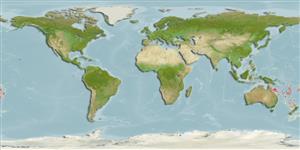Elasmobranchii (tubarões e raias) (sharks and rays) >
Carcharhiniformes (Ground sharks) >
Scyliorhinidae (Cat sharks) > Scyliorhininae
Etymology: Cephaloscyllium: cephalus, from kephale (Gr.), head, referring to its very broad and depressed head; skylion, Greek for dogfish or small shark. (See ETYFish); signourum: signa, from signum (L.), flag; oura (Gr.), tail, but used here as an adjective (tailed), referring to distinctive flag-like dark marking on terminal lobe of caudal fin. (See ETYFish).
More on authors: Last, Séret & White.
Environment: milieu / climate zone / depth range / distribution range
Ecologia
marinhas bentopelágico; intervalo de profundidade 480 - 700 m (Ref. 76946). Tropical
Western Pacific: Australia; possibly occurring off the islands of New Caledonia, Fiji, and Vanuatu.
Tamanho / Peso / Idade
Maturity: Lm ? range ? - ? cm
Max length : 74.1 cm TL (female)
Descrição suscinta
Morfologia | Morfometria
This medium-sized species has the following set of characters which was based on the holotype: head 7.5% TL in height, trunk 16.3% TL in width; origin of first dorsal-fin is over the anterior pelvic-fin base; prenarial 3.6% TL in length; preorbital snout length is 2.0 times prenarial length, 3.0 in prepectoral length, 6.6 in prepelvic length; snout-vent length long, 51.7% TL; nostril width 2.7% TL; eye-spiracle space narrow, 0.5% TL; pectoral fin medium-sized, its height 12.8% TL, posterior margin 11.9% TL; anal fin tall, 4.0% TL; anal-caudal space is 5.0% TL; precaudal length is 76% TL; interdorsal space is 6.6% TL; teeth with 3 well-developed cusps near symphysis of upper jaw; mostly unicuspidate flank denticles; back without the greatly enlarged denticles; adult clasper unknown; vertebral centra 115-116; tooth count high, 84 teeth in upper jaws, 97 in lower jaws; color of upper half of body medium brown, with a variegated pattern that is not clearly demarcated from the ventral surface; dark saddles (10) evident on body and tail; dorsal fins are pale variegated; dark blotch absent over gills; marking on posterior margin of terminal lobe of caudal fin dark, anteriorly directed, V-shaped; upper surface of pectoral-fin with a dark brown central blotch; centered over ventral origin of caudal fin is a well-developed saddle; ventral surface is uniformly greyish or white in color; juveniles are pale with dark transverse markings appearing as narrow bars and hollow saddles; markings between spiracles not separated into two unconnected pseudo-ocelli (Ref. 76946).
Ciclo de vida ou comportamento de acasalamento
Maturidade | Reprodução | Desova | Ovos | Fecundidade | Larvas
Last, P.R., B. Séret and W.T. White, 2008. New swellsharks (Cephaloscyllium: Scyliorhinidae) from the Indo-Australian region. In Last, P.R., White, W.T. & Pogonoski, J.J. (eds.): Descriptions of New Australian Chondrichthyans. CSIRO Marine and Atmospheric Research Paper no. 22. (Ref. 76946)
Status na Lista Vermelha da UICN (Ref. 130435)
Ameaça para os humanos
Harmless
Uso pelos humanos
Mais informação
Nomes comunsSinônimosMetabolismoPredadoresEcotoxicologiaReproduçãoMaturidadeDesovaAgregação de desovaFecundidadeOvosDesenvolvimento dos ovos
Idade/TamanhoCrescimentoPeso-comprimentoComprimento-comprimentoFrequências de comprimentoMorfometriaMorfologiaLarvasDinâmica larvalRecrutamentoAbundânciaBRUVS
ReferênciasAquaculturaPerfil para aquaculturaEstirpesGenéticaElectrophoresesHereditariedadeDoençasProcessamentoNutrientsConversão de massa
ColaboradoresFotosStamps, Coins Misc.SonsCiguateraVelocidadeTipo de nataçãoÁrea branquialOtólitosCérebrosVisão
Ferramentas
Relatórios especiais
Baixar XML
Fontes da internet
Estimates based on models
Preferred temperature (Ref.
123201): 6.2 - 10.2, mean 7.7 °C (based on 119 cells).
Índice de diversidade filogenética (Ref.
82804): PD
50 = 0.5000 [Uniqueness, from 0.5 = low to 2.0 = high].
Bayesian length-weight: a=0.00263 (0.00139 - 0.00497), b=3.21 (3.04 - 3.38), in cm total length, based on LWR estimates for this (Sub)family-body shape (Ref.
93245).
Nível Trófico (Ref.
69278): 4.1 ±0.5 se; based on size and trophs of closest relatives
Resiliência (Ref.
120179): médio(a), tempo mínimo de duplicação da população 1,4 - 4,4 anos (Preliminary K or Fecundity.).
Fishing Vulnerability (Ref.
59153): Moderate to high vulnerability (50 of 100).
